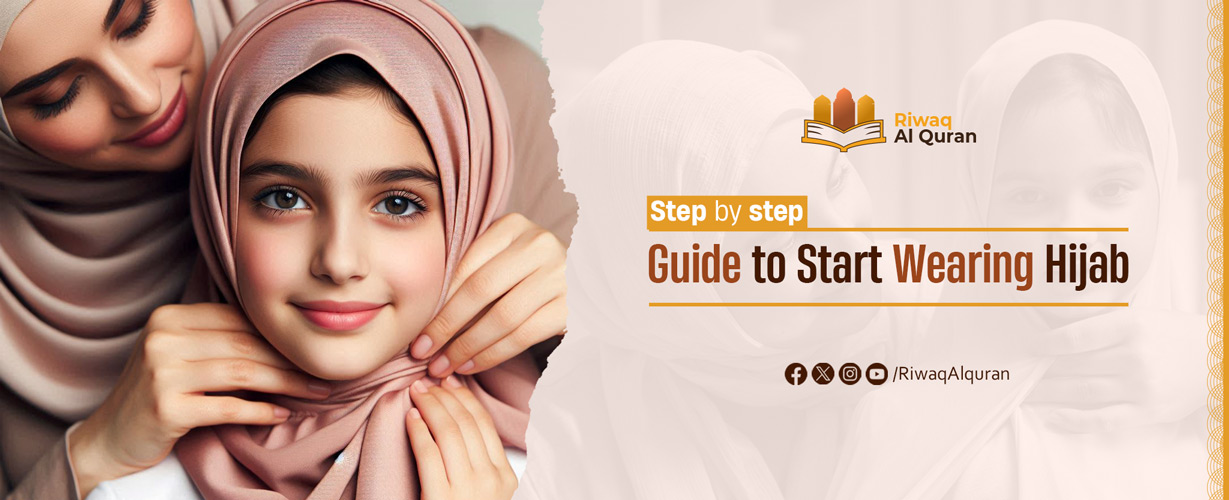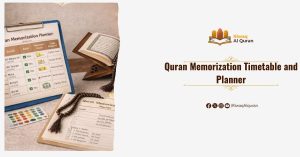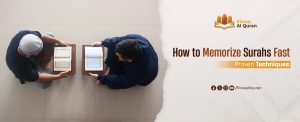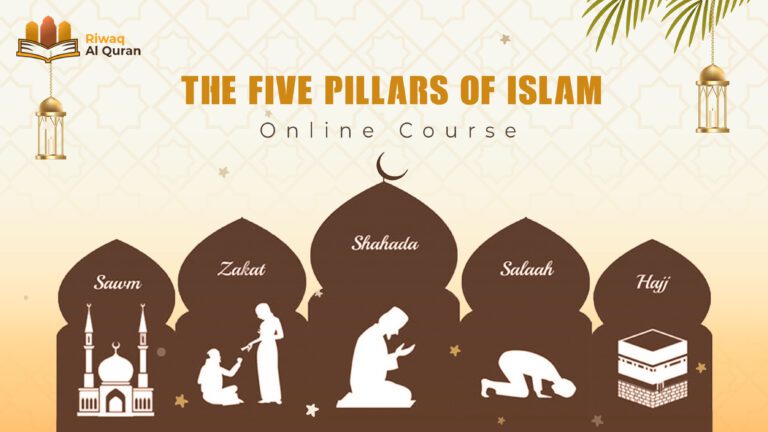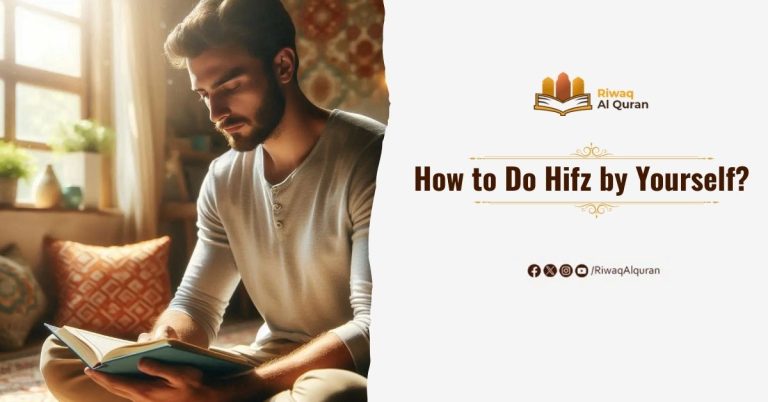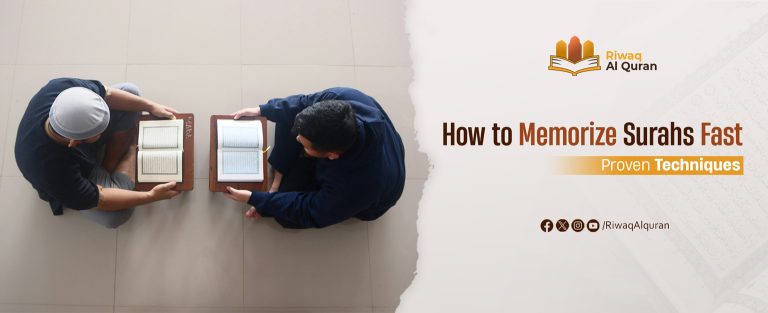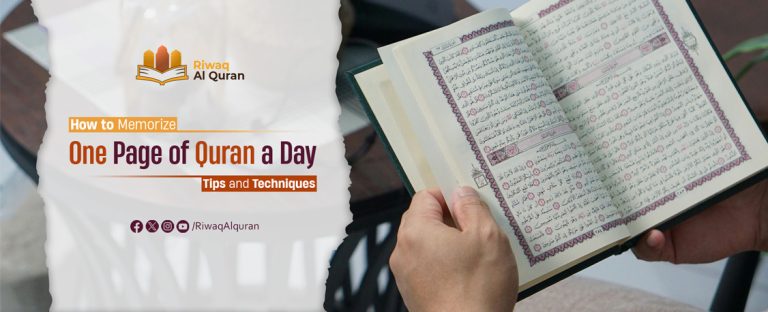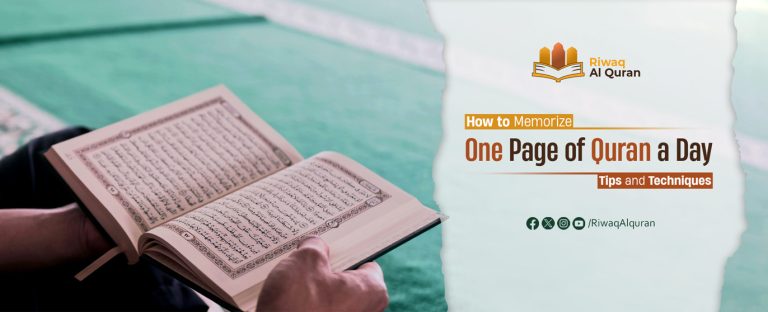Deciding to start wearing the hijab is a significant step for many Muslim women. It is a journey that involves both personal and spiritual growth. This guide will help you understand the steps, considerations, and benefits of embracing the hijab.
You might be planning on wearing a hijab one day down the line. You’re not sure when and don’t want to think about it. Maybe you’re a girl who can’t stop thinking about the obligation you need to fulfill with your Creator and need advice on how to start dressing more modestly. Maybe you already wear hijab and are struggling with self-confidence and need motivation to continue.
Table of Contents
Is the Hijab imposed in Islam?
Hijab is mandatory for all Muslim women who have reached puberty.
Quran and Hadith provide evidence supporting this obligation. Specifically, Allah instructs in Surah Al-Ahzab (33:59):
“O Prophet! Tell your wives and your daughters and the women of the believers to draw their cloaks (veils) all over their bodies…”
يَا أَيُّهَا النَّبِيُّ قُل لِّأَزْوَاجِكَ وَبَنَاتِكَ وَنِسَاءِ الْمُؤْمِنِينَ يُدْنِينَ عَلَيْهِنَّ مِن جَلَابِيبِهِنَّ ۚ ذَٰلِكَ أَدْنَىٰ أَن يُعْرَفْنَ فَلَا يُؤْذَيْنَ ۗ وَكَانَ اللَّهُ غَفُورًا رَّحِيمًا
Sunnah: Aishah (may Allah be pleased with her) said:
“May Allah have mercy on the first Muhajir women. When Allah revealed the words ‘and to draw their veils all over Juyubihinna (i.e. their bodies, faces, necks and bosoms)’ [al-Nur 24:31] they tore their aprons and covered their faces (ikhtamarna) with them.” (Narrated by al-Bukhari, 4480; Abu Dawud, 4102)
It was narrated that Umm Salamah said:
When the words ‘draw their cloaks (veils) all over their bodies’ were revealed, the women of the Ansar went out as if there were crows on their heads because of the way they covered themselves. (Narrated by Abu Dawud, 4101; classed as sahih by Shaykh al-Albani in Sahih Abu Dawud)


Benefits of Wearing The Hijab for Women in Islam
Have you ever wondered why many Muslim women choose to wear the hijab? The hijab is not just a piece of cloth; it’s a powerful symbol of faith, modesty, and identity. While it may seem like a simple headscarf to some, its significance runs much deeper. So, let’s dive into the benefits of wearing the hijab for women in Islam and discover how this practice impacts various aspects of life.
Read more about Why Do Women Wear Hijab?
The hijab is a Sign of Devotion between Allah and Muslim women
it is a clear declaration of a woman’s faith and devotion to Allah. It’s a constant reminder of her commitment to Islamic values and principles.
- Spiritual Reflection: Wearing the hijab encourages women to focus on their spiritual growth and maintain a strong connection with their faith.
- Inner Peace: Many women report feeling a sense of inner peace and contentment when they wear the hijab, knowing they are fulfilling a religious obligation.
Obedience to Divine Command
For many Muslim women, wearing the hijab is an act of obedience to Allah’s commandments.
It’s mentioned in the Quran: “And tell the believing women to lower their gaze and guard their private parts and not expose their adornment except that which [necessarily] appears thereof and to wrap [a portion of] their headcovers over their chests…” (Quran 24:31).
This act of obedience is seen as a form of worship.
Promoting Modesty in the society
The hijab helps women maintain modesty in their appearance, which is a core value in Islam. By covering their hair and body, women can protect their privacy and maintain a dignified presence.
- Preventing Objectification: The hijab serves as a barrier against being judged solely based on physical appearance.
- Fostering Respect: It encourages others to respect women for their intellect and personality rather than their looks.
- Modesty in Behavior: Wearing the hijab also influences a woman’s behavior, encouraging her to act with modesty and humility. It serves as a reminder to uphold Islamic values in all interactions.
- Encouraging Humility: The hijab helps women focus on inner qualities like kindness, compassion, and humility.
- Promoting Dignified Conduct: It reinforces the importance of maintaining dignity and respect in both personal and public interactions.
Empowerment and Identity for women in society
Empowering Women: Contrary to common misconceptions, many women feel empowered by wearing the hijab. It allows them to take control of how they present themselves and reclaim their bodies from societal expectations.
- Self-Expression: The hijab provides a means of expressing one’s faith and identity proudly.
- Challenging Stereotypes: By choosing to wear the hijab, women can challenge and break down stereotypes about Muslim women and their roles in society.
Strengthening Identity in Islam
The hijab is a powerful symbol of identity for many Muslim women. It connects them to their cultural and religious heritage and fosters a sense of belonging.
- Cultural Connection: Wearing the hijab helps women stay connected to their cultural and religious roots.
- Sense of Belonging: It creates a sense of solidarity and sisterhood among Muslim women, fostering a supportive community.
Social and Psychological Benefits
- Building Community: The hijab helps build a sense of community among Muslim women. It acts as a unifying symbol, creating bonds of sisterhood and mutual support.
- Shared Values: The hijab signifies shared values and beliefs, strengthening communal ties.
- Support Network: Women who wear the hijab often find a supportive network of like-minded individuals who share their experiences and challenges.
Boosting confidence and self-esteem:
Wearing the hijab can boost a woman’s confidence by allowing her to focus on her inner qualities and strengths rather than societal beauty standards.
- Self-Confidence: Many women feel more confident and self-assured when wearing the hijab, as it allows them to embrace their true selves.
- Inner Strength: The hijab empowers women to find strength in their faith and identity, fostering resilience and self-assurance.
Addressing Common Misconceptions
Is the Hijab Oppressive?
One common misconception is that the hijab is a symbol of oppression. However, for many women, wearing the hijab is a personal and voluntary choice that reflects their faith and values.
- Personal Choice: Many women choose to wear the hijab out of their own free will and see it as an empowering and liberating practice.
- Cultural Misunderstandings: It’s important to recognize that the hijab can be misunderstood due to cultural and societal biases.
Can Non-Muslims Understand the Hijab?
Non-Muslims can certainly understand and appreciate the significance of the hijab by learning about its religious and cultural importance.
- Education and Awareness: By educating themselves about the hijab and its meaning, non-Muslims can develop a deeper understanding and respect for this practice.
- Promoting Tolerance: Understanding the hijab helps promote tolerance and respect for diverse cultural and religious practices.
The benefits of wearing the hijab for women in Islam are multifaceted, encompassing spiritual, social, and psychological aspects. Far from being a mere piece of clothing, the hijab is a profound symbol of faith, modesty, and empowerment. By embracing the hijab, Muslim women can maintain a strong connection to their faith, express their identity, and foster a sense of community and solidarity.
How to start wearing The Hijab?
Have you been contemplating how to start wearing the hijab? It’s a significant step in a Muslim woman’s life, reflecting both faith and personal growth. keep reading guides you through the process, offering practical tips and spiritual insights to help you embrace this beautiful journey with confidence.
Be prepared to address questions and handle peer pressure with confidence. Embrace the spiritual growth, empowerment, and sense of community that come with wearing the hijab. Remember, the hijab emphasizes modesty, faith, and identity, connecting you to a broader Muslim community.
First: Understanding and Preparation for Wearing The Hijab
1. Educate Yourself
Begin by learning about the religious, cultural, and personal significance of the hijab. Read Islamic texts, consult knowledgeable individuals, and understand the reasons behind wearing it.
2. Self-Reflection
Reflect on your motivations for wearing the hijab. Whether for spiritual growth, personal identity, or commitment to faith, understanding your reasons will strengthen your resolve.
3. Family and Community Support
Discuss your decision with family and friends. Their support can provide a strong foundation as you begin this journey.
Second: Starting to Wear the Hijab
1. Gradual Introduction
Start by wearing the hijab in familiar, comfortable settings. Gradually increase its use in more public places as you gain confidence.
2. Comfortable Styles
Experiment with different styles and fabrics to find what suits you best. Comfort is key to maintaining long-term commitment, Consider factors like climate and activities. Choose lighter fabrics for hot weather and thicker ones for cold climates.
Third: Overcoming Challenges When Wearing The Hijab
Wearing the hijab is a personal and spiritual journey that involves understanding, preparation, and commitment. By educating yourself, reflecting on your motivations, and seeking support, you can embrace the hijab with confidence and pride. Remember, the hijab is not just about covering the head; it embodies values of modesty, faith, and identity, connecting you to a larger community of Muslim women.
1. Be Prepared
You should be Addressing Concerns By being prepared to answer questions and address misconceptions. Educating others can foster understanding and respect.
Maybe you have Peer Pressure, Stay true to your motivations and seek support from those who respect your decision. Remember why you chose to wear the hijab.
2. Know more from Others (Community of women)
Please seek advice from women who have been wearing the hijab for a while, Their experiences can provide valuable guidance, Do not allow those who ask you to take it off and Maintain a positive attitude and celebrate your milestones.
Join Support Groups, Know more women who have been wearing a hijab for a long time, and ask for a support group where you can share experiences and seek advice.
There may be times when you feel like removing the hijab due to external pressures. Revisit your reasons and seek support to maintain your commitment.
Addressing Common Concerns
- Facing Social Pressure: Wearing the hijab can sometimes attract unwanted attention or questions. Be prepared with polite and confident responses. Remember, your decision is personal and rooted in your faith.
- Balancing Fashion and Modesty: Contrary to popular belief, wearing the hijab doesn’t mean sacrificing fashion. There are countless ways to look stylish while maintaining modesty. Follow fashion bloggers and influencers who wear the hijab for inspiration.
Starting to wear the hijab is a significant and personal journey. It’s a blend of spiritual commitment, personal growth, and cultural expression. By taking gradual steps, seeking support, and staying true to your faith, you can embrace this beautiful practice with confidence and grace. Remember, the hijab is not just about covering your head; it’s about unveiling your true self.
When to Start Wearing the Hijab?
Starting to wear the hijab is a personal and spiritual journey that requires preparation, reflection, and commitment. By understanding its significance, preparing thoughtfully, and overcoming challenges, you can embrace the hijab with confidence and pride.
Starting to wear the hijab is often undertaken after a girl reaches puberty, marking the age of religious responsibility in Islam. Puberty is identified by signs such as menstruation, growth of coarse hair around private parts, nocturnal emissions, or reaching the age of fifteen.
Beyond physical signs, individual readiness and understanding of the hijab’s significance are crucial. Girls need to reflect on their reasons, whether for spiritual growth, personal identity, or religious duty, and to feel mentally and emotionally prepared to embrace the hijab with confidence and pride.
The Prophet (peace and blessings of Allah be upon him) said: “The Pen has been lifted from three: from the child until he reaches puberty, from the sleeper until he wakes up, and from the one who has lost his mind until he recovers.” (Narrated by Abu Dawud, 4402).
There are four signs of puberty that males and females have in common:
- Nocturnal emissions (wet dreams)
- Growth of coarse hair around the private parts
- Reaching the age of fifteen
- The sign of puberty for females in Islam is Menstruation
Puberty and Beyond
Traditionally, the hijab is worn after a girl reaches puberty. This marks the transition to adulthood in many Islamic cultures, Puberty is generally seen as the age of religious responsibility when girls become accountable for their actions in the eyes of Islam.
The age of puberty for women varies from one girl to another and also varies from one country to another.
Beyond age, individual readiness is crucial. It’s important to feel mentally and emotionally prepared. Girls should have a thorough understanding of the hijab’s significance and purpose before they start wearing it.
How to Start Wearing a Hijab at School and Work? Is It Difficult?
Starting to wear a hijab at school and work can be a challenging but manageable and rewarding journey. With a little confidence, preparation, and support, you can integrate the hijab into your daily life, reflecting your faith and identity with pride.
Conditions for the legal hijab in Islam
By wearing a Hijab, women protect themselves from any lustful gaze or act that may expose them to temptation or any kind of harassment. The hijab does not only refer to the head covering but to the whole dress of a woman. This means that there are certain requirements for a woman’s dress in Islam:
- It must cover the whole body.
- It must not be tight or transparent.
- It must not delineate the parts of the body.
- It must not be clothing that is usually worn by men.


Learn Quran, Arabic, And Islamic Studies Online With The Best Native Tutors
Riwaq Al Quran is a comprehensive online platform that offers personalized Quran, Arabic and Islamic Studies Online classes for individuals of all ages and backgrounds.
Their experienced instructors use a structured curriculum to cover Tajweed, Tafsir, and Memorization, providing easy and effective access to learning the Quran.
The advanced online classes allow for seamless communication and interaction between students and teachers. Join Riwaq Al Quran for a deeper connection with the Quran.
We offer several courses such as:
- Online courses for kids.
- Online Quran classes for kids and adults.
- Online Arabic courses
- Online Ijazah courses
- Online Islamic Studies courses.
Here are a sample of our set of Quran Courses that will be helpful for you:
- Online Tafseer Course: Delve into Quranic meanings with our insightful online Tafseer course.
- Noorani Qaida Online: Learn Quranic basics efficiently through our Noorani Qaida online program.
- Online Quran Recitation Course: Enhance Quranic recitation skills through our expert-led online course.
- Online Tajweed Classes: Master Tajweed rules for beautiful Quranic recitation in online classes.
- Quran Memorization Online Course: Memorize the Quran effectively with our specialized online memorization course.
- Online Qirat Course: Explore diverse Qirat styles with our comprehensive online Qirat course.
- Online Quran Classes for Kids: Nurture a love for the Quran in kids through interactive online classes.
Conclusion
In light of the above, we conclude that a Muslim woman is required to cover her entire body except her face and hands, according to the majority of scholars belonging to all schools of thought. Covering the head is not a disputed issue among them: they all agree that this is a necessary part of Hijab.
Starting to wear the hijab is a significant personal and spiritual journey for many Muslim women, typically beginning at puberty, which is marked by signs such as menstruation or reaching the age of fifteen. Understanding the hijab’s significance, reflecting on motivations, and seeking support from family and community are essential steps.
Begin gradually by wearing the hijab in comfortable settings, choosing styles that suit you, and being prepared to address questions and peer pressure. Embracing the hijab fosters spiritual growth, reinforces Islamic values, and connects you to a broader Muslim community.

